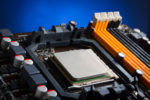ASRock A320M HDV Motherboard Review

Quick Overview
FEATURES
QUALITY
PRICE
Pros
Cons
Unlike our other reviews, this ASRock A320M HDV motherboard review focuses on what a previous-gen chipset can put to the table.
Far better models already exist, but the A320 chipset still occupies a spot in the PCs of a vast number of households. Here’s why.
ASRock A320M HDV Motherboard Review
Before going over the ASRock A320M HDV features, let’s discuss who this product is for and what accessories come with it.
Who Is This Product For?
You might be wondering why we are featuring a motherboard from 2017 when there are plenty of better options in the market.
The following is a list of people who can benefit from this board:
- For Those On a Tight Budget
The tech market already has the latest AM4 motherboards to replace older platforms, such as the A320 chipset.
However, the newer motherboards can come at a hefty price that is not welcoming for plenty of consumers.
While there are cheaper options, such as X470 and B450 motherboards, many entry-level PC builders just can’t compete with the price.
The older and much cheaper A320 platform on the ASRock A320M HDV is a perfect solution for a low-budget PC build.
ALSO READ: Asus ATX DDR3 2600 FM2 Motherboard Crossblade Ranger Review
- For Those With a Ryzen APU
If you have an extra APU lying around collecting dust, you can put it to several more years of servitude with the A320M HDV.
As long as it’s a Bristol Ridge, you won’t even have to purchase a graphics card to build a system with graphics support.
- For Those Who Do Not Want to Use a Graphics Card
Conversely, since the A320M HDV works with Ryzen APUs, you can reduce your expenses and build something workable.
If you just want to assemble a PC with light graphics support, you absolutely won’t need a GPU and a CPU to work it.
Instead, all you need is an A-Series APU that fits in the AM4 socket of the A320M HDV.
- For Those Who Do Not Overclock
The ASRock A320M HDV supports some overclocking features with some CPUs.
However, we do not recommend it for extreme overclockers who tend to push their PC components beyond their limits.
This motherboard is better suited for those who need a board that works just fine, even without overclocking.
- For Casual Light Gamers
This motherboard does not have any apparent features that scream capabilities for extreme gaming.
As such, we only recommend it for users who plan to combine work tasks and casual gaming with low to average hardware requirements.
On the other hand, you will need a motherboard with the Gaming tag if you plan to play games using heavy computing loads.
What’s Included?
The ASRock A320M HDV Motherboard comes with the minimum essential accessories and installation media.
In addition to the quick installation guide and support CD, the set includes an I/O shield, two SATA data cables, and one M.2 socket screw kit.
Overview of the Features
The ASRock A320M HDV is a micro-ATX motherboard carrying the AMD Promontory A320 chipset.
While the M suffix designates the mATX form factor, the HDV label means this motherboard supports high-def video playback.
We already mentioned that this board works for AMD Socket AM4 A-Series Bristol Ridge APUs.
However, you will find that it can also operate well with a Ryzen CPU.
You can choose from Matisse, Picasso, Summit Ridge, Raven Ridge, and Pinnacle Ridge Ryzen processors.
The motherboard uses a Digi Power design with seven power phases to support a CPU up to 65 watts.
- BIOS Setup
This motherboard comes with a 128MB AMI UEFI Legal BIOS with a graphical user interface.
Setup is pretty much straightforward with this board, as it supports a plug-and-play installation.
- Memory Allowances
Unlike many modern micro-ATX motherboards, the A320M HDV only has two DDR4 DIMM sockets supporting up to 16GB RAM modules each.
This memory allowance limits the RAM capacity to 32GB, but it permits memory modules with base frequencies up to 3200MHz.
Nevertheless, 32GB of system memory is enough for regular computer tasks and light games.
Furthermore, the dual memory sockets provide consumers with a legitimate area for increasing their savings for a PC build.
Of course, 3200MHz DIMMs aren’t typically cheap, but pairing them with an APU is far thriftier than installing a CPU and a discreet graphics card.
On another note, having a Matisse CPU already sets the maximum base frequency at 3200MHz.
Using a Pinnacle Ridge, Summit Ridge, or Raven Ridge will require some overclocking if you want to accomplish the 3200MHz speed.
- Expansion Options
Since ASRock included APU support in the design of the A320M HDV, it limits expansion options to just one full-sized socket and one x1 slot.
The x16 socket supports PCIe 3.0 devices, but you can only add a PCIe 2.0 device on the x1 slot.
If you plan to pair a CPU with a graphics card, you can use the single x16 socket. However, you can also install an NVMe SSD boot disk into this socket.
- Storage Interface
ASRock also limits the storage interface of the A320M HDV to four SATA 6Gbps connectors and one Ultra M.2 socket.
The Ultra M.2 socket supports both PCIe 3.0 SSDs and SATA drives, but you can also use it for an NVMe SSD boot disk.
Although the storage connectors are pretty minimal on this board, they should be enough for simple tasks and casual gaming.
Plenty of SATA drives nowadays carry an average capacity of 500GB to 1TB.
- Graphics Support
If a tight budget hinders you from getting a graphics card, you might as well pair this board with an APU instead of a CPU.
Since an APU combines a CPU and a GPU into one chip, you won’t have to purchase a separate GPU for better graphics.
This board takes full advantage of the integrated AMD Radeon Vega or R-Series Graphics in Ryzen Series APUs.
With an APU, the default shared memory is 2GB, but you can bump that up to 16GB if you have a 32GB system memory capacity.
The A320M HDV comes with three display output options: D-Sub, DVI-D, and HDMI.
The board allows three monitors simultaneously, but you will need an adapter for a monitor with a DisplayPort socket.
Maximum allowable resolutions are 4096x2160 at 24Hz for HDMI, 1920x1200 at 60Hz for DVI-D, and 2048x1536 at 60Hz for D-Sub.
Both DVI-D and HDMI connectors support High-Bandwidth Digital Content Protection version 1.4 and Full HD 1080p Blu-ray playback.
If you plan to use this build for animations, you can benefit from compliant HDMI monitors that support Auto Lip Sync, Deep Color, and xvYCC.
Finally, you’ll like that this motherboard comes with graphics support utility apps, such as DirectX 12 and Pixel Shader 5.0.
- Audio Features
The A320M HDV boasts 7.1-channel high-def audio components using the Realtek ALC887 Audio Codec.
These components support surge protection and the accompanying ELNA caps improve noise level control.
If you want to take advantage of High Bit Rate (HBR) Audio, it also comes with compliant monitors that use an HDMI connection.
- Network Connectivity
Although this motherboard does not have a wireless adapter, it carries a Realtek RTL8111GR LAN controller.
It is a PCIe x1 Gigabit LAN device that supports Wake-On-LAN, ESD protection, LAN cable detection, and PXE.
Furthermore, it can also utilize Energy Efficient Ethernet 802.3az.
- Rear Panel I/O
The rear panel of this motherboard does not have the I/O shield pre-installed. As such, you will have to attach it during installation.
The rear panel has a PX/2 combo port, two USB2.0, four USB3.1, the Ethernet port, and three analog audio jacks.
All USB ports support ESD protection, and the Ethernet port carries some LEDs that indicate activity and connection speed.
The three analog audio jacks are for Line-In, Front Speaker, and Mic-In.
All of these ports are in addition to the three display output connectors previously mentioned.
- Internal Connectors
You can have four more USB2.0 ports and two more USB3.1 ports routed from some internal headers.
Plus, these extra USBs will also support ESD protection.
Other internal connectors include front panel audio, Print Port, COM Port, Trusted Platform Module, CPU Fan, two system fans, and chassis intrusion.
The chassis intrusion connector doubles as a speaker header.
How To Get the Most Out Of It
The best way to save on costs and maximize the potential of the A320M HDV is by pairing it with an APU.
Even a discreet graphics card paired with a CPU can make the build tear up your budget faster than you might think.
With an APU, you won’t have to purchase a separate graphics card.
Another way to keep this motherboard running several more years than its intended lifetime is by using it under normal workloads and light gaming only.
This motherboard permits overclocking with some CPUs, but ASRock did not design it for extreme workloads and high-end gaming.
Overclocking may make your software run smoothly during the first several tries, but it will definitely take a toll on the motherboard lifespan.
Alternatives
If you need to build a PC on a tight budget, you might be wondering if currently available motherboards can give you everything you need.
While plenty of newer models tend to break the bank, older A320 chipset models still exist, and some options have the feature set for your needs.
If you think the ASRock A3320M HDV does not precisely fit your required build profile, here are some alternatives:
1. ASUS Prime A320M-K
The ASUS Prime A320M-K is another a320 micro-ATX motherboard that costs cheaper than the ASRock A320M HDV.
Even so, this board has some notable advantages over the A320M HDV.
While it supports the same memory module frequencies and storage connection capacities, it has two PCIe x1 slots instead of just one.
Furthermore, it uses an eight-channel audio component, which is slightly better than the A320M HDV’s 7.1.
This motherboard came out three months before the release of the A320M HDV.
2. Gigabyte A320M-S2H
Another option that sits at a similar price point as the ASUS Prime A320M-K is the Gigabyte A320M-S2H.
This board’s advantage over the ASRock A320M HDV is its maximum RAM capacity of 64GB, albeit having only two memory slots.
Gigabyte released the A320M-S2H during the first quarter of 2018, which means it is slightly newer than the A320M HDV.
3. MSI A320M-A Pro
The MSI A320M-A Pro’s release in the first quarter of 2020 makes it a far newer model than the ASRock A320M HDV.
However, you will find that it costs a few bucks more than the A320M HDV.
Like the A320M-S2H, this MSI board has a RAM capacity of 64GB.
Another advantage is its use of more advanced components that shout better durability across the board.
RELATED: NZXT Motherboard Review (Guide)
Is the ASRock A320M HDV Any Good?
While this ASRock A320M HDV Motherboard review analyzes a motherboard from early in 2017, it deserves attention for several reasons.
First and foremost, assembling a workable build can be a real challenge for budget-conscious consumers.
Since the A320 is a viable chipset for a reasonable workaround, ASRock uses it and trims down some features while maintaining all essential components.
Some of our alternatives can be much cheaper, but ASRock ensures that this board adds high-def video to its core features.








